My death, story one
 |
| ” I misstep, I slip, I misjudge the weight of my pack…” |
Death, to me, is a bullet in the back of the head. Let us look at the scene — the bullet, almost spent, perhaps just starting to tumble, unexpected; a mile away, the sniper, already putting away his weapon, perhaps having intended to hit someone else, bored with his job, thinking about his next assignment, already thinking about dinner. Here is a true story:
Death, to me, is capricious, a mistake. Death is always late, or early. Death is overworked, disorganized, not very bright. Death goes home to dinner and frets about the paperwork. We laugh when we narrowly escape from death, because death is stupid.
There is a special narrative of almost-being-dead, which may perhaps shed some light on death and the way in which we should understand our understanding of death. I am not claiming that almost-being-dead provides any kind of privileged access to an understanding of death; but I think that how we read a story of almost-being-dead is a challenge and test of any claim to understand.
Yalom the prescriptivist
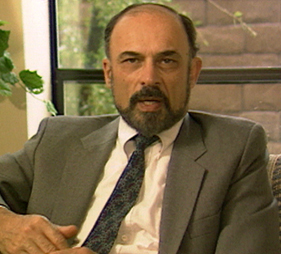 |
| Irvin Yalom |
My thinking about the narrative of almost-being-dead began with an odd remark by Irvin Yalom in his classic Existential Psychotherapy (1980). Yalom is reviewing conceptions of death in children — such ideas as that death stabs you with a knife, death is white as snow, death has a key to everywhere, death leaves footprints behind, death comes and takes people away. Yalom sees these stories — he calls them personifications — as a form of denial, reassuring, he says, in contrast to the truth. “As long as a child believes that death is brought by some outside force or figure,” he says, “the child is safe from the really terrible truth that death is not external — that, from the beginning of life, one carries within the spores of one’s own death” (p. 99; emphasis in original).
Yalom is here making reference to Heidegger’s famous description of death as that possibility “which is one’s ownmost (eigenste), which is nonrelational (unbezügliche), and which is not to be outstripped (unüberholbare)” (1927/1962, § 50, p. 294) — a description which, Yalom says, is the truth. The children are already, in Heidegerrian terms, tranquilized, inauthentic, irresolute, lost.
Yet what is striking about this discussion is the degree to which the children are expressing the alterity of death, the extent to which the children seem to recognize that death threatens from beyond. As Emmanuel Levinas puts it, “This unknown that frightens, the silence of the infinite spaces that terrify, comes from the other, and this alterity, precisely as absolute, strikes me in an evil design or in a judgment of justice” (Levinas, 1969, p. 234; emphasis added). And again:
In the being for death of fear I am not faced with nothingness, but faced with what is against me, as though murder, rather than being one of the occasions of dying, were inseparable from the essence of death, as though the approach of death remained one of the modalities of the relation with the Other. The violence of death threatens as a tyranny, as though proceeding from a foreign will. The order of necessity that is carried out in death is not like an implacable law of determinism governing a totality, but is rather like the alienation of my will by the Other (1969, p. 234).
Heidegger’s Being and Time was available to Yalom in English in 1962, and Levinas’s Totality and infinity was available to him in English in 1969. Yet, in 1980, Heidegger’s view of death is the truth from which the children hide, and Levinas — who sheds a remarkable light on these naïve responses — is not mentioned at all.
The story of Carlos
Yalom talks about his therapy of a patient named Carlos, who was dying of lymphoma and what Yalom considered to be a really bad attitude. Carlos was pugnacious, combative, crude, and selfish. His aim in life, he told Yalom, was to screw as many different women as he could. Rendered impotent by his chemotherapy, his sexual life consisted entirely of masturbating while watching sadomasochistic pornography. He expressed a desire to rape women if only it were legal to do so (1989, p. 77, 81).
Carlos, Yalom writes, “was so preoccupied with women that he seemed to forget that he had a cancer that was actively infiltrating all the crawl spaces of his body” (p. 79). Yalom “often thought that if I could find a way to keep him continually aware of his death and the ‘clearing’ that death effects, I could help him make some major changes in the way he related to life and to other people” (p. 83; emphasis added). You will, I suppose, be pleased to learn that Yalom did in fact guide Carlos toward an acceptance of his impending death, whereupon Carlos became a good father to his estranged children and a supportive and sensitive member of his therapy group.
I am not so sure. I rather liked the old Carlos — crude, nasty, full of fury. Everything he said told the story of his voracious clinging to life, a stubborn refusal to acknowledge his ravaged and emaciated body, his rage against the dying of the light. What Yalom saw as “pathetic cosmetic efforts — a wide-brimmed Panama hat, painted-on eyebrows, and a scarf to conceal the swellings in his neck” — could be read instead as an obstinate refusal to go gently into that good night. Yalom saw Carlos as inauthentic; but perhaps Carlos was in fact a wild man, a berserker in the face of death — a death that threatened him from beyond, that he fought against, with furious rage.
The argument from almost-being-dead
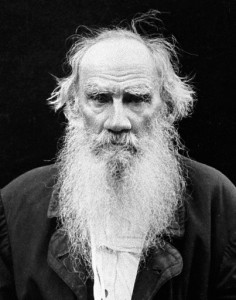 |
| Leo Tolstoy |
Yalom supports his prescription of Heideggerian authenticity by citing several stories of life-changing encounters with death — that is, narratives of almost-being-dead. He gives two examples from Leo Tolstoy — Pierre in War and Peace (1931), whose life is transformed from meaninglessness to purpose when he is unexpectedly reprieved from imminent death by firing squad; and the protagonist in The Death of Ivan Ilyich (1960), whose fatal sickness and extraordinary pain lead him, in his final days, to transform his life.
And Yalom mentions, in a footnote, the case of Fyodor Dostoyevsky, who was in real life reprieved at the last moment from death by firing squad, although his personal transformation was apparently delayed until some time later, when he began to study the New Testament at the gulag to which he was then sent (Yalom, 1980, pp. 33-40; see also Gelven, 1989, p. 141).
Yet, to the extent that Yalom, or Heidegger, asserts that an encounter with death — that is, almost-being-dead — is either a necessary or sufficient condition for authenticity — or, as Yalom puts it, “making some major changes in the way one relates to life and to other people” (1989, p.77) — then the claim is empirically false. As philosopher Julian Young points out, many people face up to death in the most vivid, direct, and literal way possible without it making any appreciable difference to their lives at all. Conversely, people make all sorts of life changes — including becoming authentic and resolute — for all sorts of reasons, not only by coming to terms with death, but for love, anger, hatred, or sheer stubborness (Young, 1998, pp. 114-115).
Woody Allen on almost-being-dead
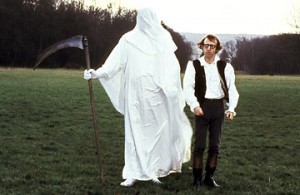 |
| Woody Allen and friend |
Woody Allen has his own story about almost-being-dead. In his short play Death Knocks (1966) — a parody of the famous chess game with Death in Ingrid Bergman’s The Seventh Seal — Nat Ackerman, a bald, paunchy fifty-seven-year-old dress manufacturer, is confronted by Death, who has climbed a drainpipe and crawled into Nat’s apartment through the window. Nat challenges Death to a game of gin rummy, which Nat wins easily, getting twenty-eight dollars and an additional twenty-four hours of life. After Death leaves, despondent, with no money and no place to stay for the night, Nat calls his friend Moe Lefkowitz and says:
Hello, Moe? Me. Listen, I don’t know if somebody’s playing a joke, or what, but Death was just here. We played a little gin … No, Death. In person. Or somebody who claims to be Death. But, Moe, he’s such a schlep!
Blanchot’s death
In 1994, Maurice Blanchot published one of his typically odd, elliptical, obscure stories, entitled The Instant of my Death (L’instant de ma mort). The story takes place in the closing days of World War II, when a young Frenchman — who may or may not be Blanchot himself — is dragged from his castle and is about to be shot by a Nazi firing squad. Facing the firing squad, he achieves a peculiar exaltation:
I know — do I know it — that the one at whom the Germans were already aiming, awaiting but the final order, experienced then a feeling of extraordinary lightness, a sort of beatitude (nothing happy, however) — sovereign elation? The encounter of death with death?
In his place, I will not try to analyze. He was perhaps suddenly invincible. Dead — immortal. Perhaps ecstasy. Rather the feeling of compassion for suffering humanity, the happiness of not being immortal or eternal. Henceforth, he was bound to death by a surreptitious friendship (2000, p. 5).
At the last moment, the young Frenchman — like Dostoevsky — is reprieved. Describing the reaction to this reprieve, Blanchot writes the following utterly remarkable passage:
There remained, however, at the moment when the shooting was no longer but to come, the feeling of lightness that I would not know how to translate: freed from life? The infinite opening up? Neither happiness, nor unhappiness. Nor the absence of fear and perhaps already the step beyond. I know, I imagine that this unanalyzable feeling changed what there remained for him of existence. As if the death outside of him could only henceforth collide with the death in him. “I am alive. No, you are dead” (pp. 7-9).
There is a blank page. Then the young man returns to Paris, speaks with Malraux, commiserates over a lost manuscript. “What does it matter,” writes Blanchot. “All that remains is the feeling of lightness that is death itself or, to put it more precisely, the instant of my death henceforth always in abeyance” (p. 11).
Impossible stories
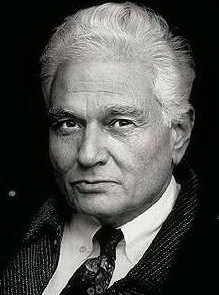 |
| Jacques Derrida |
Can we even tell such stories of almost-being-dead? In 1995, Jacques Derrida, at an international colloquium on Passions de la littérature, gave one of his typically odd, elliptical, obscure close readings of the rich Blanchot text. Derrida does not, of course, clarify. But he does point to the special and ineluctably private nature of the narrative of almost-being-dead: “This surviving speech must be exemplarily irreplaceable as the instance of the instant from which it speaks, the instant of death as irreplaceable, as ‘my death,’ on the subject of which no one other than the dying person can testify. I am the only one who can testify to my death — on the condition that I survive it” (2000, p. 45).
And, indeed, for Blanchot, all story, all narrative, partakes of the narrative of almost-being-dead. In The Writing of the Disaster (1995b), a meditation on the Holocaust, Blanchot says, “To write one’s autobiography, in order either to confess or to engage in self-analysis, or in order to expose oneself, like a work of art, to the gaze of all, is perhaps to seek to survive, but through a perpetual suicide — a death which is total inasmuch as fragmentary” (p. 64). And Derrida comments: “Allow me to call to mind an essential kind of generality: is the witness not always a survivor?” (2000, p. 45).
Derrida states, “I cannot, I should not be able to, testify to my own death, only to the imminence of my death, to its instance as deferred imminence. I can testify to the imminence of my death” (2000, p. 46). He connects that instance with the very last words of Blanchot’s story — “the instant of my death henceforth always in abeyance (en instance)” (2000, p. 11) — and that imminence of that impossible dying with Blanchot’s words, “Impossible necessary death: why do these words — and the unexperienced experience to which they refer — escape comprehension?” (1995b, p. 67). Derrida says: “Dying means: you are dead already, in an immemorial past, of a death that was not yours.”
What is special about the unexperienced experience of death, the impossible necessary death, “the incessant imminence whereby life nonetheless endures by desiring” (Blanchot, 1980/1995, p. 41), the narrative of almost-being-dead, is this: “Death will come, there is a suspension, a last suspensive delay, an interruption of the death sentence. But what will come, what is coming at me, this is what will already have taken place: death has already taken place. I can testify to it, because it has already taken place. Yet this past, to which I testify, namely, my death itself, has never been present” (Derrida, 2000, pp. 49-50).
But this “imminence of what has already come to pass,” (Blanchot, 1980/1995, p. 41) is sharply different, Blanchot says, from any sort of Heideggerian being-toward-death. “This uncertain death, always anterior, the vestige of a past that never has been present, is never individual, just as it overflows the whole” (Blanchot, 1980/1995, p. 66) — a statement that Derrida says is “troublesome even to the Jemeinigkeit, the ‘mine every time,’ which according to Heidegger essentially characterizes a Dasein that announces itself to itself in its own being-for-death” (Derrida, 2000, p. 51).
Blanchot on death
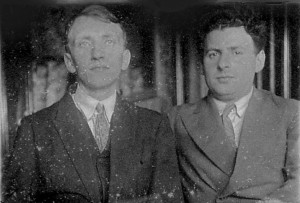 |
| Maurice Blanchot and his lifelong friend Emmanuel Levinas |
It is apparently true that Blanchot, at the age of 36, was captured and almost executed for Resistance activities during the war, but was miraculously saved at the last minute (Hill, 1997, p. 12; Mole, 1997, p. 163). But The Instant of my Death is filled with slippery identifications. The text begins, autobiographically, “I remember…,” but the speaker remembers, not himself, but “a young man,” who may or may not be Blanchot. And this young man is saved because of a further confusion of identity: the executioners are not Germans at all, but rather Russians, who take the young man, the text suggests, for a nobleman, the lord of the Château, and spare him on that basis, choosing instead to kill some innocent peasants (Blanchot, 2000, p. 3, 5-6; Mole, 1997, p. 166).
Blanchot’s fictional writings are filled with death, but no one dies quickly: death is always a long passage through a debilitating illness, where the character “is forever dying but not dead” (Haase & Large, 2001, p. 52). Indeed, all we know is dying; death itself remains forever alien. That is why, at the instant of his death, the young man facing the firing squad, Blanchot says, was “prevented from dying by death itself” (p. 3). Death always means the death of the other; but even the death of the other remains a mystery:
The fact that we cannot experience the reality of death to the end makes death unreal, and this irreality condemns us to fear dying only unreally, not really to die, to remain as if we are held, forever, between life and death, in a state of non-existence and non-death, from which our whole life perhaps takes its meaning and its reality. We do not know that we die. We do not know either that others die, for the death of another remains foreign to us and always incomplete, since we who know it, we are alive (Blanchot, 1995a, p. 252).
Because we are all dying all the time, death is always imminent:
Dying means: you are dead already, in an immemorial past, of a death which was not yours, which you have thus neither known nor lived, but under the threat of which you believe you are called upon to live; you await it henceforth in the future, constructing a future to make it possible at last––possible as something that will take place and will belong to the realm of experience (Blanchot,
1995b, 65).
Yet it is precisely this unknowable imminence of death that binds us all together:
What calls me most radically into question? Not my relation to myself as finite or as the consciousness of being before death or for death, but my presence in the proximity of another who by dying removes himself definitively, to take upon myself another’s death as the only death that concerns me (Blanchot, 1988, p. 9).
And it is this imminence of death that gives our stories meaning. “My speech,” Blanchot says, “is a warning that at this very moment death is loose in the world, that it has suddenly appeared between me, as I speak, and the being I address: it is there between us as the distance that separates us, but this distance is also what prevents us from being separated, because it contains the condition for all understanding. Death alone allows me to grasp what I want to attain; it exists in words as the only way they can have meaning. Without death, everything would sink into absurdity and nothingness” (1995a, p. 323-324).
Strikingly, then, death is very much like the coming of the Messiah — never arriving, always present. “And if it happens to the question “When will you come?’ the Messiah answers ‘Today,’ the answer is certainly impressive: so it is today! It is now and always now. There is no need to wait, although to wait is an obligation. And when is it now?” (Blanchot, 1995b, p. 142).
My death, story two
The question is this. Isn’t this, not the reading, but rather the attempt at a reading which we should give to a story like this if presented by another? Isn’t our task hermeneutical rather than prescriptive? Here is another true story.
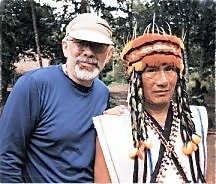 |
| “We had been living in a Shapra village…” |
Levinas reads the Talmud
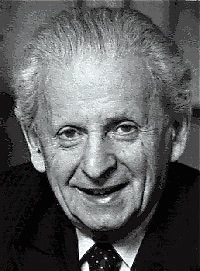 |
| Emmanuel Levinas |
It is clear that Levinas considers himself to be a phenomenologist, although not a Husserlian. “I think that, in spite of everything,” he says, “what I do is phenomenology, even if there is no reduction, here, according to the rules required by Husserl; even if all of the Husserlian method is not respected” (1986/1998, p. 87). In a discussion with Raoul Mortley, Levinas said, “My method is phenomenological; it consists in restoring that which is given, which bears a name, which is objective, to its background of intention, not only that intention which is directed towards the object, but to everything which calls it to concreteness, to the horizon” (Mortley, 1991, p. 140, quoted in Moran, 2000, p. 327).
Husserlian intentionality, says Levinas, is merely an adequation with the object; what defines consciousness at its fundamental level is, instead, “the astonishing feat of containing more than it is possible to contain” — that is, welcoming the other, hospitality, where “the idea of infinity is consummated,” where one is open to the infinity of the other (1969, p. 27). As Moran puts it, Levinas believes that Husserl’s emphasis on intentionality is a distortion of human experience; the caress of a lover cannot be captured in any account of intentionality (2000, p. 329).
But this approach to “that which is given” in listening to another is precisely Levinas’s hermeneutical approach to that which is given in a text —specifically, the Talmud. For Levinas, “the capacity of these texts to signify is infinite” (Aronowicz, 1990, p. x), and only successive “secularizations,” translations into the language of the times, can bring these infinite meanings to light.
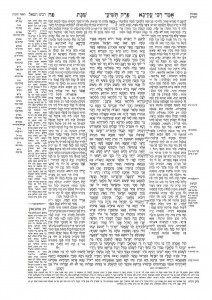 |
| Babylonian Talmud, Tractate Shabbat 88a |
Levinas explicates this text from the Tractate Shabbat, 88a and 88b: “A Sadducee saw Raba buried in study, holding his fingers beneath his foot so tightly that blood spurted from it” (Levinas, 1990, p. 31). Levinas notes what a strange sight this was. “One might have expected to see Raba meditating dreamily, while caressing his beard or rubbing his hands. Raba’s gesture is odd: he rubs his foot so hard that blood spurts out. That was the degree to which he forgot himself in study!” (p. 46).
But then Levinas draws the hermeneutical lesson. Perhaps Raba was giving plastic expression to the intellectual work in which he was engaged; perhaps “rubbing until the blood spurts out” is the way one must rub the text to arrive at the life it conceals, to tear from the words the secrets which time and convention have covered with sediment, to remove the layer which corrodes them (p. 47). To reveal these secrets is “an exertion, a battle, a tearing or wresting of meaning from the text” (Aronowicz, 1990, p. xvii), which requires not one but many interpreters. Within the text are enclosed an infinite number of meanings that require a plurality of people “in their uniqueness, each one capable of wresting meanings from the signs, each time inimitable” (Levinas, 1982, p. 136, translated in Aronowicz, 1990, p. xvi). Cannot the same be said of the infinity of human stories? Levinas says:
It all happens as though the multiplicity of persons . . . were the condition for the fullness of “absolute truth,” as though each person, through his uniqueness, ensured the revelation of a unique aspect of the truth, and that certain sides of it would never reveal themselves if certain people were missing from mankind (Levinas, 1982, p. 163, translated in Aronowicz, 1990, p. xvi).
For Levinas truth is sought within infinity in multiple readings. Prescriptivism, then, is a form of mere adequation, a totalizing of the other, rather than hospitality to the infinity of the other, as if someone were missing in the world.
My death, story three
 |
| “On the Rio Marañon, still far from Iquitos…” |
How do we read a story?
What we need, then, is a hermeneutics that is humble before the story. And if the proper object of hermeneutic understanding is meaning, then the scope of hermeneutic analysis includes not only texts but also — since human action is inherently meaningful — all forms of human action as well. There is nothing humanly meaningful that falls outside of language. There is, Hans-Georg Gadamer says, “no societal reality . . . that does not bring itself to representation in a consciousness that is linguistically articulated” (1976, p. 35). Reality, he says, “happens precisely within language” (p. 35). The other speaks to us by actions — even combative, crude, and selfish actions — that we read as stories.
Gadamer emphasizes the essential linguisticality (Sprachlichkeit) of all human experience of the world; as he puts it, “Being that can be understood is language” (Sein, das verstanden werden kann, ist Sprache) (1975, p. xxii). Paul Ricoeur too views action “on the model of the text” (Ricoeur, 1981a); anthropologist Clifford Geertz has compared the work of the anthropologist to that of the literary critic, “sorting out the structures of signification” in the texts we call cultures (1973, pp. 9-10; see generally Madison, 1997). Gadamer says that “reading is the basic structure that is common in all occurrences of meaning” (1997, p. 53).
Similarly, linguisticality pervades our encounters; we understand each other in terms of stories. People and narratives share teleological qualities. An episode is understood by its place in the narrative, not simply as the result of prior causal forces. An episode is meaningful because it points both backwards and forwards; it makes sense because it contributes to the future action. “It is a bad storyteller,” says philosopher David Cooper, “who introduces episodes that make no such contribution” (1999, p. 73).
The basic structure underlying a coherent life story has been called a personal myth (e.g., McAdams, 1993; Larsen, 1996; Feinstein & Krippner, 1997). Similar concepts — all invoking linguisticality — include personal fables (Elkind, 1981); nuclear themes (Tomkins, 1992); core images (Clift, 1992). Indeed, Stephen Crites (1971) says that the very organization of human experience seems to be given to us in narrative. Paul Ricoeur asks: What is it to remember? “It is to be able to constitute one’s own existence in the form of a story where a memory as such is only a fragment of the story” (Ricoeur, 1981c, p. 253; emphasis added).
What is important here is that no text, no story, no human life is exhausted by a single reading — like the Talmud to Levinas, all stories are infinite. “There is always more than one way of construing a text” (Ricoeur, 1976, p. 79); every interpretation dips into the infinite narrative, is provisional, humble. Language provides us with understandings; but they are understandings waiting to be more fully understood, as we both reflect on them and let them articulate our initial experience of things (Sokolowski, 1997, p. 228).
The text or narrative is like a musical score (Ricoeur, 1976, p. 75) or like the script of a play (Sokolowski, 1997, p. 229) — the same type among many tokens, the same object prescribing various manifolds of appearance. In telling our stories to each other, however, unlike other hermeneutical enterprises, the story talks back.
“Each person is like a poem waiting to be released,” write Richard Hycner (1991, p. 102). Here the hermeneutical task is to “resonate to the unique rhythm and rhyme,” to have a sense of wonder, “to be amazed” — in other words, to be humble before the infinite narrative, the holy text, “to allow myself to be touched by the mysteriousness, wondrousness, and grandeur of the person” (p. 103). As in any hermeneutic endeavor, the goal is to understand, to appreciate the experiential narrative (p. 106), to hear the text of the story even through the speech of the body (pp. 119-120).
Every narrative, every story, is a story of almost-being-dead, of deferred imminence. If stories of almost-being-dead — mine, or Blanchot’s, or yours — demand a special form of listening, then every story demands the same humble and respectful approach, the same hermeneutic — a sense of wonder at the infinity of the human text.
My stories
What am I then to make of my narratives of almost-being-dead, and others I have not told? What is true? What has been reconstructed by romantic memory, influenced by Levinas, Blanchot, Derrida? As I read my own texts, what do I come to understand about the meaning of death to me, or the meaning of my death?
The most striking thing in my own narratives of almost-being-dead is the way in which death constantly appears to me from the outside, but not — as for Levinas — as an evil design or judgment of justice, as tyranny, murder, a foreign will (Levinas, 1969, p. 234); rather, death comes as a mistake, stupid and blundering, coming at the wrong time or for the wrong person, because someone made a wrong move, avoidable. As long as I am still alive I have fooled death, the big schlep.
It is also striking that death becomes visible to me, in recollection and perhaps in actuality, in small things, glimpses and gestures — rocks below a cliff, a bolt on an automatic weapon. Being still alive after almost being dead is expressed to me in things to do with air — first the explosive release of laughter, but then, more important, in the intense awareness of the quiet motion of the air moving in and out of my body.
Finally, there is Blanchot’s surreptitious friendship with death, the incessant imminence of death. How do I read Blanchot’s infinite text, or my own infinite text? Almost being dead means, sometimes, not often, when stopping to think, that death has somehow been incorporated into life. Almost being dead means, paradoxically, that I have lived most fully, and that I am therefore most able to die. It is just a matter of practice.
But that is my death — not yours.
REFERENCES
Allen, W. (1966). Death knocks. In Getting even (pp. 41-53). New York, NY: Random House.
Aronowicz, A. (1990). Translator’s introduction. In Levinas, E. Nine Talmudic readings (A. Aronowicz, Trans.) (pp. ix-xxxix). Bloomington, IN: Indiana University.
Blanchot, M. (1988). The unavowable community. (P. Joris, Trans.). Barrytown, N.Y.: Station Hill.
Blanchot, M. (2000). The instant of my death (E. Rottenberg, Trans.). Palo Alto, CA: Stanford University.
Blanchot, M. (1995a).The work of fire (C. Mandell, Trans.). Palo Alto, CA: Stanford University.
Blanchot, M. (1995b). The writing of the disaster (New ed.) (A. Smock, Trans.). Lincoln, NE: University of Nebraska.
Cioffi, F. (1998). Was Freud a liar? In Cioffi, F. Freud and the question of pseudoscience (pp. 199-204). Chicago, IL: Open Court.
Clift, J. (1992). Core images of the self: A symbolic approach to healing and wholeness. New York, NY: Crossroad.
Cooper, D. (1999). Existentialism: A reconstruction (2nd ed.). Oxford, UK: Blackwell.
Crites, S. (1971). The narrative quality of experience. Journal of the American Academy of Religion, 39(3), 291-311.
Derrida, J. (2000). Demeure: Fiction and testimony (E. Rottenberg, Trans.). Stanford, CA: Stanford University.
Elkind, D. (1981). Children and adolescents: interpretive essays on Jean Piaget. New York, NY: Oxford University.
Feinstein, D., & Krippner, S. (1997). The mythic path. New York, NY: G. P. Putnam’s Sons.
Gadamer, H.-G. (1975). Truth and method (G. Barden & J. Cumming, Trans.). New York, NY: Seabury.
Gadamer, H.-G. (1976). Philosophical hermeneutics (D. Linge, Trans.). Berkeley, CA: University of California.
Gadamer, H.-G. (1997). Reflections on my philosophical journey. (R. Palmer, Trans.). In Hahn, L. (Ed.), The philosophy of Hans-George Gadamer (pp. 3-63). Chicago, IL: Open Court.
Geertz, C. (1973). The interpretation of cultures. New York, NY: Basic Books.
Gelven, M. (1989). A commentary on Heidegger’s Being and Time (Rev. ed.). DeKalb, IL: Northern Illinois University.
Haase, U. & Large, W. (2001). Maurice Blanchot. New York, NY: Routledge.
Heidegger, M. (1962). Being and Time (J. Mcquarrie & E. Robinson, Trans.). New York, NY: Harper & Row. (Original work published 1927)
Heidegger, M. (1982). The basic problems of phenomenology (A. Hofstadter, Trans.). Bloomington, IN: Indiana University. (Original work published 1927)
Hill, L. (1997). Blanchot: Extreme contemporary. New York, NY: Routledge.
Hycner, R. (1991). Between person and person: Toward a dialogical psychotherapy. Highland, NY: The Gestalt Journal.
Larsen, S. (1998). The shaman’s doorway: Opening imagination to power and myth. Rochester, VT: Inner Traditions.
Levinas, E. (1969). Totality and infinity (A. Lingis, Trans.). Pittsburgh, PA: Duquesne University.
Levinas, E. (1982). L’au-dela du verset. Paris: Les Editions de Minuit.
Levinas, E. (1990). Nine Talmudic readings (A. Aronowicz, Trans.). Bloomington, IN: Indiana University.
Levinas, E. (1998). Of God who comes to mind (B. Bergo, Trans.). Stanford, CA: Stanford University.
Madison, G. (1997). Hermeneutics’ claim to universality. In Hahn, L. (Ed.), The philosophy of Hans-George Gadamer (pp. 349-365). Chicago, IL: Open Court.
McAdams, D. (1993). The stories we live by: Personal myths and the making of the self. New York, NY: The Guilford Press.
Minkowski, E. (1958). Findings in a case of schizophrenic depression. In May, R., Angel, E., & Ellenberger, H. (Eds.), Existence: A new dimension in psychiatry and psychology (pp. 127-138). New York, NY: Basic Books.
Mole, G. D. (1997). Levinas, Blanchot, Jabes: Figures of estrangement. Gainesville, FL: University Press of Florida.
Moran, D. (2000). Introduction to phenomenology. London, UK: Routledge.
Mortley, R. (1991). Levinas. In French philosophers in conversation. London, UK: Routledge.
Palmer, R. (1969). Hermeneutics: Interpretation theory in Schleiermacher, Dilthey, Heidegger, and Gadamer. Evanston, IL: Northwestern University.
Polt, R. (1999). Heidegger: An introduction. Ithaca, NY: Cornell University.
Ricoeur, P. (1976). Interpretation theory: Discourse and the surplus of meaning. Fort Worth, TX: Texas Christian University Press.
Ricoeur, P. (1981a). The model of the text: meaningful action considered as a text. In Ricoeur, P., Hermeneutics and the human sciences (J. Thompson, Trans.) (pp. 197-221). Cambridge, UK: Cambridge University.
Ricoeur, P. (1981b). Hermeneutics and the human sciences (Thompson, J., Trans.). Cambridge, UK: Cambridge University Press.
Ricoeur, P. (1981c). The question of proof in Freud’s writings. In Ricoeur, P., Hermeneutics and the human sciences (Thompson, J., Trans.) (pp. 247-273). Cambridge, UK: Cambridge University Press. (Original work published 1977)
Sokolowski, R. (1997). Gadamer’s theory of hermeneutics. In Hahn, L. (Ed.), The philosophy of Hans-George Gadamer (pp. 223-234). Chicago, IL: Open Court.
Tolstoy, L. (1931). War and peace. New York, NY: Modern Library.
Tolstoy, L. (1960). The death of Ivan Ilyich and other stories. New York, NY: Signet Classics.
Tomkins, S. (1992). Affect, imagery, consciousness: Cognition, duplication, and transformation of information. New York, NY: Springer.
von Eckartsberg, R. (1998). Existential-phenomenological research. In Valle, R. (Ed.), Phenomenological inquiry in psychology (pp. 21-61). New York, NY: Plenum Press.
Yalom, I. (1980). Existential psychotherapy. New York, NY: Basic Books.
Yalom, I. (1989). Love’s executioner and other tales of psychotherapy. New York, NY: HarperCollins.
Young, J. (1998). Death and authenticity. In Malpas, J., & Solomon, R. (Eds.), Death and philosophy (pp. 112-119). London, UK: Routledge.

- Previous Post: Thinking About Death II: Levinas
- Next Post: Fourteen Dead Shamans
- More Articles Related to: Books and Art



Wonderful piece. For another angle on that place between life an death, check of the subcomandante Marcos interview at the end of the doc “A place called Chiapas” It´s here
http://www.youtube.com/watch?v=mTD9EOB-xTo
starting at minute 1, but the entire doc is in YouTube, well worth a watch
Hello Steve
I’m absolutely loving your Blog. So many topics of personal interest intelligently written about, and many colored with very pertinent, relevant personal experiences. Thanks for being so damn well experienced, refreshingly frank and honest.
I would like to comment on the death topic from a different point of view. I wont share the whole relative content, it would be ridiculously long winded. But here goes:
In 2001, just before 9/11 unfolded, I was in a seriously negative and challenged personal space. I was living in an absolutely beautiful place, but I was “alone” in my hell, and could think of nothing but the desire to die. I had had enough “experiences of another-worldly-nature”, including that of Ayahuacsa, to understand that suicide was totally out of the question for me; so I, very sincerely, yelled, screamed, begged and prayed to be “allowed” to leave this mortal plane…
It didn’t take very long to be “gifted” Hepatitis E. That disease does not happen in my country. So it was a surprise to the doctor who diagnosed me. He asked me if I had recently been traveling, and although I had traveled extensively in my life prior that, I had been where I was, for 3 years, without a trip OS.
So there I was lying in bed in rabid pain, now wondering how long it would take to get it all over with; The pain, in an arch over my ears from my neck, in my head, was beyond excruciating (I later found that that is the line of the liver meridian). The pain was so intense, and I wanted to die anyway, that I took enough pain killers to finish me off either way. In that state, I experienced something very similar to an Ayahuasca dream/journey.
From inside a bedroom of a house I had previously lived in; through the window, I saw the upper side profile of a guy I saw quite regularly in town, but didn’t know. He was looking up towards the sky.
My spirit was launched towards him, and then catapulted through his apparent visual trajectory, to space; but I didn’t arrive in “space”. I arrived in a city, standing in front a rotund man with round John Lennon type sun glasses on; all of which was made of a mercury-like liquid metal. I figured I was now dead, but to my disappointment, the man told me I had work to do and couldn’t stay. Then he took off his glasses to expose pools of metallic liquid as eyes; I was sucked into them, and was immediately back, but now minus the pain in my head.
None of it visually appeared to be what one would consider a “classical NDE”. No tunnel leading to a bright white light, no beautiful paradisaical “heaven”. It looked like how I would imagine Russia to look like for some reason. Im not Russian, nor do I have any Russian ancestry, as far as this life shows.
When I was diagnosed, I was told they had nothing to treat Hep E with, and basically, “good luck!” It took 8 months to heal; I would never ever wish that much suffering on anyone. I learned my lesson. Careful what you wish/pray for. But it wasn’t the death that was painful, it was the intensely painful journey to that door, and the consequential painfully long time, and physical pain, involved in the healing process that was torturous beyond words.
The moral of tale is that I now believe that our experience of life, and our understanding of our inevitable death is what creates, to a great extent, the context of what we experience while we’re “living in these bodies”. As if we’re currently on our way to the exit door right now, and our death is actually unfolding, in concert, through every breath we take; like we have X amount of breaths or heartbeats to live in the body, and are formally released into death at exactly the appropriate time. Ive been held at gunpoint by a guy who had already done time for murder; I once came seriously close to a shark attack. Had I been even inured with a serious bite, because of the remoteness of the location, I would have certainly bled out and died.
To me, no matter “how” we go, death doesn’t unfold before, or after, its cosmically appropriate. Even when we’re “kept alive” by human intervention. Its appropriate. Whose to say that that experience has no meaning or value, to not only the Soul of the individual experiencing it, but others who are affected by the trauma of that event or process? Its a damn shame that death gets such a bad rap, because I believe we actually attract traumatic “near misses” (to show us where the fear and misunderstanding lead to, and to get past it), as a result of that misunderstanding, and we, and others generally suffer as a result, instead of gain a more meaningful relationship to that which is inevitable. Death of only the physical body.
Also, ultimately, I see absolutely zero difference between the experience of death in an Ayahuasca ceremony, compared to the formal/real thing. I also believe that our personal experience of death will be as unique to us, as individuals, as the diverse experiences we have in those ceremonies. It depends on “where we’re at” in the moment relative to what we believe is true, and how we feel about it.
I’m waiting for the arrival of “Singing To The Plants”…with great excitement. Thanks for all your efforts Steve, you’re a very appreciated bright flame, and a radiant source of knowledge and information.